NIC-NIELIT STA 2020
Question 1 |
A is the father of B and C is the son of D. E is the brother of A. B is the sister of C. How is D related to E?
Daughter | |
Brother | |
Brother in Law | |
Sister in Law |
Question 1 Explanation:

Question 2 |
Pointing towards a picture, Ramesh said, “That picture is of the sister of the grandson of the father of my maternal uncle”. How is that lady in the picture related to Ramesh?
Mother’s sister | |
Cousin (maternal brother) | |
Cousin (maternal sister) | |
Father’s sister |
Question 2 Explanation:
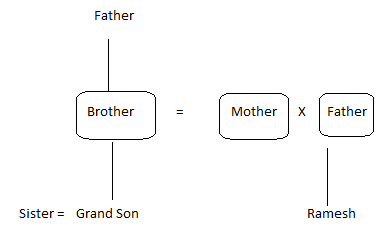
Question 3 |
Refer the statement and solve the question according to the conclusions.
Statement:
Some Pigeons are Bird;
Some Birds are Alive
Conclusion:
(I) Some Pigeons are Alive
(II) Some Birds are Pigeons
Only (I) follows | |
Only (II) follows | |
Both (I) & (II) follows | |
None follows |
Question 3 Explanation:
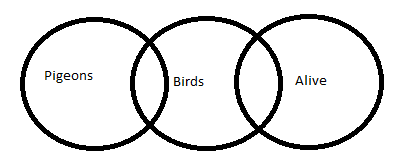
Question 4 |
If ‘CONTEMPORARY’ is coded as NOCTEMROPARY then ‘BODARDSITAND’ is the code of which letter?
DOBARDTISAND | |
BODDRASITDNA | |
DOBDRATISDNA | |
DOBARDSITAND |
Question 4 Explanation:
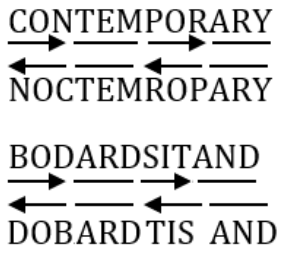
Question 5 |
Find the number which does not fit into the series
8 12 20 32 50 68
20 | |
32 | |
68 | |
50 |
Question 5 Explanation:

Question 6 |
Directions - Question number 6 to 10 are based on following information:
There are twelve persons named O, P, Q, R, S, T, U, V, W, X, Y and Z who live in a multi-storey apartment. The apartment has three floors and each floor has four rooms. These 12 persons who live in a set of 12 Rooms can be represented by a Matrix of 3 rows and 4 columns.
→Q lives immediate left below diagonally of a person who lives immediate left below diagonally of T.
→S lives immediate left above diagonally of a person who lives immediate left above diagonally of Z.
→X lives immediate right above diagonally of a person who lives immediate right below diagonally of O.
→P lives immediate right above diagonally of a person who lives immediate right above diagonally of Y.
→T lives immediate left above diagonally of a person who lives third to the right of V.
→Q lives immediate left of a person who lives two rooms below W in the same column.
→R lives to the immediate right of a person who lives immediate right above diagonally of Q. Z is living to the immediate left of U who receives ₹46000 as salary.
→The person who live on one of the floors (left to right) receive salary in the same order ₹50000, ₹48000, ₹47000 and ₹46000.
→The person who live on one of the floors (right to left) receive salary in the same order ₹45000, ₹38000, ₹35000 and ₹40000.
→The person who live on one of the floors (left to right) receive salary in the same order ₹37000, ₹42000, ₹36000 and ₹43000.
What is the aggregate salary of people living at the right end of the apartment?
₹ 137000 | |
₹ 134000 | |
₹ 125000 | |
₹ 131000
|
Question 7 |
Directions - Question number 6 to 10 are based on following information:
There are twelve persons named O, P, Q, R, S, T, U, V, W, X, Y and Z who live in a multi-storey apartment. The apartment has three floors and each floor has four rooms. These 12 persons who live in a set of 12 Rooms can be represented by a Matrix of 3 rows and 4 columns.
→Q lives immediate left below diagonally of a person who lives immediate left below diagonally of T.
→S lives immediate left above diagonally of a person who lives immediate left above diagonally of Z.
→X lives immediate right above diagonally of a person who lives immediate right below diagonally of O.
→P lives immediate right above diagonally of a person who lives immediate right above diagonally of Y.
→T lives immediate left above diagonally of a person who lives third to the right of V.
→Q lives immediate left of a person who lives two rooms below W in the same column.
→R lives to the immediate right of a person who lives immediate right above diagonally of Q. Z is living to the immediate left of U who receives ₹46000 as salary.
→The person who live on one of the floors (left to right) receive salary in the same order ₹50000, ₹48000, ₹47000 and ₹46000.
→The person who live on one of the floors (right to left) receive salary in the same order ₹45000, ₹38000, ₹35000 and ₹40000.
→The person who live on one of the floors (left to right) receive salary in the same order ₹37000, ₹42000, ₹36000 and ₹43000.
What is the salary received by a person who lives second to the right of S?
₹ 35000 | |
₹ 45000 | |
₹ 37000 | |
₹ 38000 |
Question 8 |
Directions - Question number 6 to 10 are based on following information:
There are twelve persons named O, P, Q, R, S, T, U, V, W, X, Y and Z who live in a multi-storey apartment. The apartment has three floors and each floor has four rooms. These 12 persons who live in a set of 12 Rooms can be represented by a Matrix of 3 rows and 4 columns.
→Q lives immediate left below diagonally of a person who lives immediate left below diagonally of T.
→S lives immediate left above diagonally of a person who lives immediate left above diagonally of Z.
→X lives immediate right above diagonally of a person who lives immediate right below diagonally of O.
→P lives immediate right above diagonally of a person who lives immediate right above diagonally of Y.
→T lives immediate left above diagonally of a person who lives third to the right of V.
→Q lives immediate left of a person who lives two rooms below W in the same column.
→R lives to the immediate right of a person who lives immediate right above diagonally of Q. Z is living to the immediate left of U who receives ₹46000 as salary.
→The person who live on one of the floors (left to right) receive salary in the same order ₹50000, ₹48000, ₹47000 and ₹46000.
→The person who live on one of the floors (right to left) receive salary in the same order ₹45000, ₹38000, ₹35000 and ₹40000.
→The person who live on one of the floors (left to right) receive salary in the same order ₹37000, ₹42000, ₹36000 and ₹43000.
What is the sum of salaries of Y and P?
₹ 90000 | |
₹ 99000 | |
₹ 93000 | |
₹ 89000 |
Question 9 |
Directions - Question number 6 to 10 are based on following information:
There are twelve persons named O, P, Q, R, S, T, U, V, W, X, Y and Z who live in a multi-storey apartment. The apartment has three floors and each floor has four rooms. These 12 persons who live in a set of 12 Rooms can be represented by a Matrix of 3 rows and 4 columns.
→Q lives immediate left below diagonally of a person who lives immediate left below diagonally of T.
→S lives immediate left above diagonally of a person who lives immediate left above diagonally of Z.
→X lives immediate right above diagonally of a person who lives immediate right below diagonally of O.
→P lives immediate right above diagonally of a person who lives immediate right above diagonally of Y.
→T lives immediate left above diagonally of a person who lives third to the right of V.
→Q lives immediate left of a person who lives two rooms below W in the same column.
→R lives to the immediate right of a person who lives immediate right above diagonally of Q. Z is living to the immediate left of U who receives ₹46000 as salary.
→The person who live on one of the floors (left to right) receive salary in the same order ₹50000, ₹48000, ₹47000 and ₹46000.
→The person who live on one of the floors (right to left) receive salary in the same order ₹45000, ₹38000, ₹35000 and ₹40000.
→The person who live on one of the floors (left to right) receive salary in the same order ₹37000, ₹42000, ₹36000 and ₹43000.
Who among the following lives third to the left of U?
O | |
Q | |
T | |
S |
Question 10 |
Directions - Question number 6 to 10 are based on following information:
There are twelve persons named O, P, Q, R, S, T, U, V, W, X, Y and Z who live in a multi-storey apartment. The apartment has three floors and each floor has four rooms. These 12 persons who live in a set of 12 Rooms can be represented by a Matrix of 3 rows and 4 columns.
→Q lives immediate left below diagonally of a person who lives immediate left below diagonally of T.
→S lives immediate left above diagonally of a person who lives immediate left above diagonally of Z.
→X lives immediate right above diagonally of a person who lives immediate right below diagonally of O.
→P lives immediate right above diagonally of a person who lives immediate right above diagonally of Y.
→T lives immediate left above diagonally of a person who lives third to the right of V.
→Q lives immediate left of a person who lives two rooms below W in the same column.
→R lives to the immediate right of a person who lives immediate right above diagonally of Q. Z is living to the immediate left of U who receives ₹46000 as salary.
→The person who live on one of the floors (left to right) receive salary in the same order ₹50000, ₹48000, ₹47000 and ₹46000.
→The person who live on one of the floors (right to left) receive salary in the same order ₹45000, ₹38000, ₹35000 and ₹40000.
→The person who live on one of the floors (left to right) receive salary in the same order ₹37000, ₹42000, ₹36000 and ₹43000.
What is the sum of the salaries received by the persons living on the top floor of the apartment?
₹ 158000 | |
₹ 193000 | |
₹ 157000 | |
₹ 161000
|
Question 11 |
Directions for question number 11 and 12:
Study the following information carefully and answer the question:
Group of girl’s gossip with each other. All are sitting surrounding a round table. The names of the girls are Shiksha, Radha, Chinu, Snigdha and Rani. It is not necessary that they are sitting in the order of the name as mentioned here. Radha is second to the right of Shiksha. Shiksha doesn’t sit with Chinu. Rani is second to the right of Radha. Radha sits near Snigdha.
Q11. If Radha and Snigdha change their places then who will be second to the left of Rani?
Radha | |
Snigdha | |
Shiksha | |
None of the options |
Question 11 Explanation:
According to the given passage the seating order is

If Radha and Snigdha change their places then Snigdha will be second to the left of Rani

If Radha and Snigdha change their places then Snigdha will be second to the left of Rani
Question 12 |
Directions for question number 11 and 12:
Study the following information carefully and answer the question:
Group of girl’s gossip with each other. All are sitting surrounding a round table. The names of the girls are Shiksha, Radha, Chinu, Snigdha and Rani. It is not necessary that they are sitting in the order of the name as mentioned here. Radha is second to the right of Shiksha. Shiksha doesn’t sit with Chinu. Rani is second to the right of Radha. Radha sits near Snigdha.
Q12. Who sits to the left of Shiksha?
Rani | |
Radha | |
Chinu | |
Snigdha |
Question 12 Explanation:

Question 13 |
Directions for question number 13 to 15:
Relationship between different elements is provided in the statements. The statements are followed by conclusions. Study the conclusions based on the given statement and choose the correct answer.
Q13: T >= U = V <= W < X; V >= Y
Conclusions:
(I) Y <= T
(II) U >= X
if only conclusion (I) follows | |
if only conclusion (II) follows | |
if neither (I) nor (II) conclusion follows | |
if both (I) and (II) conclusions follow |
Question 13 Explanation:
T >= U = V <= W < X; V >= Y
T>= U= V>= Y
Y <= T
T>= U= V>= Y
Y <= T
Question 14 |
Directions for question number 13 to 15:
Relationship between different elements is provided in the statements. The statements are followed by conclusions. Study the conclusions based on the given statement and choose the correct answer.
Q13: T >= U = V <= W < X; V >= Y
Q14. P <= Q <= R > S; T >= R; S >= U
Conclusions:
(I) T > S
(II) U < R
if only conclusion (I) follows | |
if only conclusion (II) follows | |
if neither (I) nor (II) conclusion follows | |
if both (I) and (II) conclusions follow |
Question 14 Explanation:
P <= Q <= R > S; T >= R; S >= U
T >= R > S R > S>=U
T>S U
T >= R > S R > S>=U
T>S U
Question 15 |
Directions for question number 13 to 15:
Relationship between different elements is provided in the statements. The statements are followed by conclusions. Study the conclusions based on the given statement and choose the correct answer.
Q13: T >= U = V <= W < X; V >= Y
Q15: A <= B < C >= D; C <= E <= F
Conclusions:
(I) F >= D
(II) A > E
if only conclusion (I) follows | |
if only conclusion (II) follows | |
if neither (I) nor (II) conclusion follows | |
if both (I) and (II) conclusions follow |
Question 15 Explanation:
A <= B < C >= D; C <= E <= F
D <= C <= E < F
F >= D
Question 16 |
Five people are standing in a row. Aman is standing next to Karan but not adjacent to Tanuj. Radhika is standing next to Priyanka who is standing on the extreme left and Tanuj is not standing next to Radhika. Who are Standing adjacent to Aman?
Radhika and Karan | |
Karan and Tanuj | |
Karan and Priyanka | |
Radhika and Tanuj |
Question 16 Explanation:

Question 17 |
Complete the following series
4, 27, 256, 3125, _____
46656 | |
6250 | |
800000 | |
1024 |
Question 17 Explanation:
22 = 4
33 = 27
44 = 256
55 = 3125
66 = 46656
33 = 27
44 = 256
55 = 3125
66 = 46656
Question 18 |
A Businessman purchases an item at a certain price and marks its price up by 30%. He sells the item at a certain discount on markup price and makes a net profit of 4% on the whole transaction. Find the discount given by a businessman on markup price.
10 | |
15 | |
26 | |
20 |
Question 19 |
Ramesh’s father is a paediatrician. Ram’s father is a trader. Krishan’s father is a school teacher. Krishan falls ill. Where should his father take him?
to home
| |
to school | |
to Ramesh’s father | |
to Ram’s father |
Question 19 Explanation:
Ramesh’s father is a paediatrician
Ram’s father is a trader
Krishan’s father is a school teacher
Krishan falls ill
According to the given input Ramesh's father is a paediatrician. So, they went to Ramesh’s father.
Ram’s father is a trader
Krishan’s father is a school teacher
Krishan falls ill
According to the given input Ramesh's father is a paediatrician. So, they went to Ramesh’s father.
Question 20 |
What is the total number of ways to reach A to B in the network given?

12 | |
16 | |
20 | |
22 |
Question 21 |
Find the missing number.
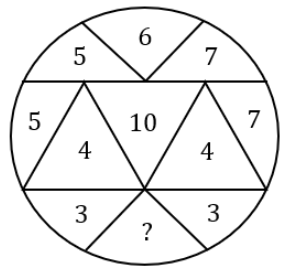
14 | |
10 | |
9 | |
3 |
Question 22 |
If 5% income of P is equal to 15% income of Q and 10% income of Q is equal to 20% income of R. If income of R is ₹ 2000, then what are the incomes of P and Q respectively?
₹ 4000 and ₹ 8000 | |
₹ 12000 and ₹ 4000
| |
₹ 15000 and ₹ 5000 | |
₹ 18000 and ₹ 6000 |
Question 22 Explanation:
5%P = (15/100)*Q
(10/100)*Q = (20/100)*R
(20/100)*2000
=4000
(10/100)*Q = 4000
Q = 4000
(5/100)*P = (15/100)*4000
=600
P = (600*100)/5
P=12000
(10/100)*Q = (20/100)*R
(20/100)*2000
=4000
(10/100)*Q = 4000
Q = 4000
(5/100)*P = (15/100)*4000
=600
P = (600*100)/5
P=12000
Question 23 |
Directions for question number 23 to 26:
Answer the questions on the basis of the data given below:
O is X’s father
Y is Z’s mother
P is O’s mother
X is Z’s sister
Q23. If P has a daughter Q, then how is Q related to Z?
Aunt | |
Mother | |
Sister | |
Daughter |
Question 23 Explanation:
If P has a daughter Q, then Q related to Z is Aunt.
Question 24 |
Directions for question number 23 to 26:
Answer the questions on the basis of the data given below:
O is X’s father
Y is Z’s mother
P is O’s mother
X is Z’s sister
Q24. How is Y related to O?
Wife | |
Sister | |
Mother | |
Daughter |
Question 24 Explanation:
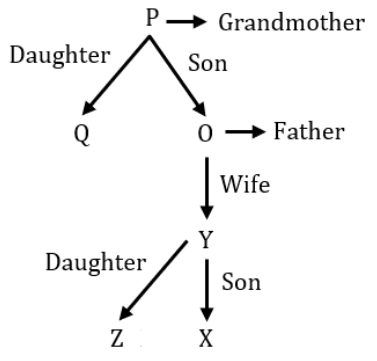
Y related to O is wife.
Question 25 |
Directions for question number 23 to 26:
Answer the questions on the basis of the data given below:
O is X’s father
Y is Z’s mother
P is O’s mother
X is Z’s sister
Q25. How is O related to Z?
Brother | |
Cousin | |
Father | |
Uncle |
Question 25 Explanation:
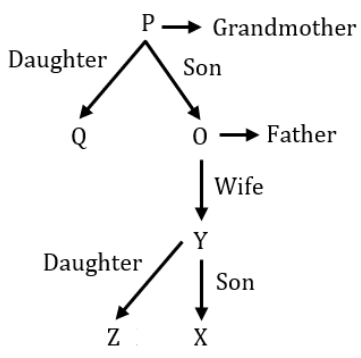
O related to Z is father.
Question 26 |
Directions for question number 23 to 26:
Answer the questions on the basis of the data given below:
O is X’s father
Y is Z’s mother
P is O’s mother
X is Z’s sister
Q26. How is P related to X?
Mother | |
Grandmother | |
Sister | |
Daughter |
Question 26 Explanation:

P related to X is Grandmother.
Question 27 |
14, 28, 20, 20, 40, 32, 64, _______
52 | |
56 | |
96 | |
128 |
Question 27 Explanation:

Question 28 |
5 16 49 104 181 ______
271 | |
298 | |
280 | |
281 |
Question 28 Explanation:

Question 29 |
In a certain code, ‘CONSIDER’ is written as RMNBSFEJ, how is ‘MONOPOLY’ written in that code?
LNMNZMPQ | |
NMNLZMPQ | |
POPNXKNO | |
NMNLXKNO |
Question 29 Explanation:
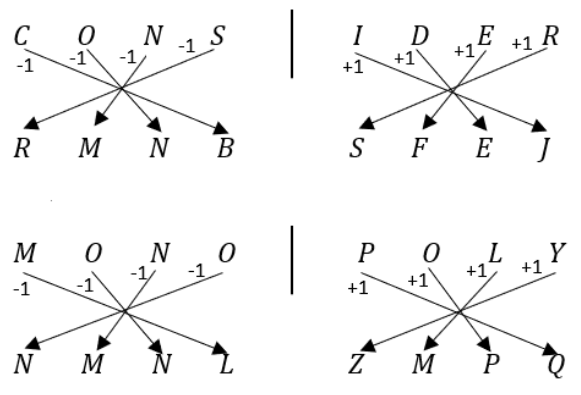
Question 30 |
Directions for question number 30 to 31:
Two statements followed by four conclusions numbered from (I) to (IV) are given. You have to take the two statements to be true even if these seem to be at variance from the commonly known facts. Read all the conclusions and decide which of the given conclusions logically follow from the two given statements disregarding commonly known facts.
Q30. All Shoes are Socks
Some Socks are Gloves
Conclusions:
(I) Some Shoes are Gloves
(II) Some Socks are Shoes
(III) All Gloves are Shoes
(IV) No Shoes are Gloves
Only (I) follows | |
Only (II) follows | |
Only (III) follows
| |
Only (IV) follows |
Question 30 Explanation:

There are 30 questions to complete.
